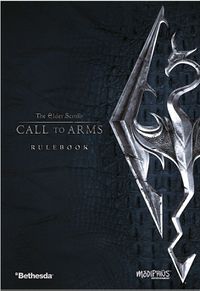Call to Arms:Core Rulebook
| Release Date | March 31, 2020 |
|---|---|
| Pages | 101 |
The Core Rulebook is a detailed guide to the gameplay of Call to Arms. It comes in the Core Rules Box Set; Modiphius has also made a free PDF of the rulebook available here. It is also available as a Steam Workshop item for Tabletop Simulator.
Modiphius has stated that the rules in their entirety cannot be reproduced, edited, translated, or reorganized in any format. They are available for free but they are not commons content. Selected sections may be reproduced for the purposes of creating reference sheets, but not the rules in their entirety.
Contents[edit]
Introduction - A letter welcoming players to the game.
- Prepare For Battle - Basic mechanics, including the Party, model height levels, cards (Character cards, Upgrade Cards, etc), the dice, the battlefield and measuring, and other components such as tokens and scenery.
- The Skill Test - How to perform a skill test, including the skill dice, attributes, modifiers, and effect dice.
- Summary of Skills - A listing of potential skills a model may have.
- Line of Sight - How to determine if a model's line of sight is clear, blocked, or obscured.
- Elevated Terrain - How line of sight is affected when models are on different terrain height levels
The Game Round - How to play a round of the game: the Advantage Phase (Advantage Token, start-of-round effects), the Activation Phase (activating models, how status effects may impact activation, replenishing stamina/magicka, performing actions, recovering), and the Event Phase (random events and end-of-round effects).
The Actions - How to perform the actions Move (including Jumping and Climbing, and passing through Difficult Terrain), Withdraw, Attack (ranged and melee attacks, special circumstances such as different terrain height), Block, Ready, Command (Rally, Hold, With Me), Aid, Hide, Pickpocket, Search, Swap Items, and Special Actions.
Damage
- Health - Determining a model's health and Injured status.
- Applying Damage - The sequence for applying damage, as well as how Injured and Incapacitated models are affected.
- Armor - Describes Armor rating, special effects, bonuses, Strong Armor, and models with no Armor rating.
- Special Effects - Applying a Special Effect when attacking or defending.
The Event Phase
- Adversaries Activate - In Battle mode only, any not-yet-activated Adversaries activate.
- Draw an Event Card - Draw a card from the Event Deck, which will either Spawn Adversaries, begin a Radiant Quest, begin a Special Quest, or be an Incident.
- End of Round - Scoring Victory Points, Leveling Up a Hero, resolving remaining effects.
Morale - When and how to make a Morale Check, and how Fleeing works.
Status Effects
- Incapacitated - Describes what Incapacitated models can and cannot do, and how they are affected by damage and effects.
- Shaken - How the Shaken status affects a model when the model is activated.
- Staggered - Describes the effects of the Staggered token on a model.
Spells
- Spell Cards - Introduces the different parts of a Spell Card.
- Targeting Types - Describes the different target types a spell may have (Aura, Blessing, Curse, Environment, Melee Attack, Personal, Ranged Attack, Rune).
- Spell Subtypes - Describes how Bound Weapon, Summon, and Ward spells work.
Dragon Shouts - How Dragon Shouts work - the basics, boosting Shouts, range and targeting types, Sneak Attacks, and recovering Thu'um.
Terrain - Different types of terrain and how they affect movement: Normal Terrain, Difficult Terrain, Barriers (including Locked Doors), Impassable Terrain, Gaps, Falling Damage, Large Obstacles (and how to climb and jump down), Area Terrain such as swamps or forests, Edge of the Battlefield, and Deadly Terrain Effects (such as acid pools, fire pits, lava, and bottomless pits).
Adversaries - Introduces Adversary models, their Character Cards, and the different types (Minions, Elite, Masters).
- Using Adversaries - How Adversaries are Activated and affected by Status Effects.
- Target Priorities - How to determine which models an Adversary will attack.
- Adversary Responses - The five types of Responses an Adversary may perform (Attack, Move, Objective, Fall Back, Defend) and how each one works, notes on Adversary Activations in different situations, Recover, and Adversaries in Delve Mode.
Special Rules
- Keywords - A list of about 60 special rules that may be listed on character, weapon, etc. cards.
- Special Attack Rules - Special rules for certain attacks, including Area Effect, Scatter, and Damage Types (Fire, Force, Frost, Shock).
- Perks - A list of over 100 special rules that Heroes may have.
Races of Tamriel - A list of special abilities each race has, as well as different types of creatures (Daedra, Dwemer Animunculi, Beasts, Monsters, Undead), and the three Paths that each model may belong to (The Path of Might, The Path of Shadow, and The Path of Sorcery).
Gathering the Party
- Gold Septims - Setting a limit how many models can be "purchased" for a party.
- Factions - An overview of Factions (Adventurers, Imperial Legion, Stormcloaks, Bandits) and their special rules, as well as neutral models.
- Party Composition - All of the types of models that can be part of a party (the Champion, Faction Heroes, Followers, Familiars, Hirelings), plus their Upgrade Cards, Equipment, Spells and Shouts.
- Upgrades - How to "purchase" and use upgrades for your party.
- Equipment - The items that may be equipped (such as food, amulets, etc), Treasure, Enchantments, Quest Items.
Appendices - Tokens Index, Icons Index, book Index, Quick Reference.
